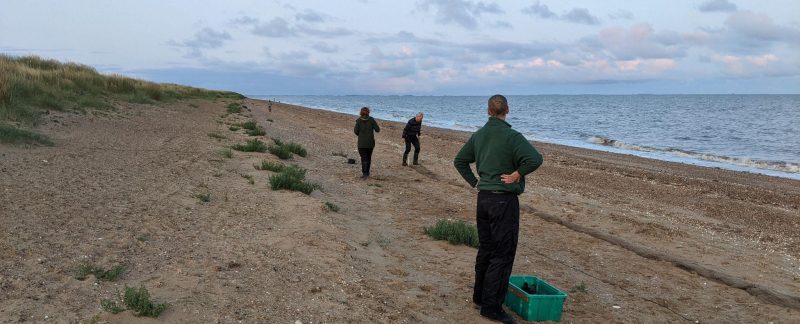Saturday 21 August
The team started to arrive around midday with Cathy being the first with Katharine soon after (to claim the best tent spots), soon followed by Nigel, Jacquie, Sam and Skye. Once tents were up and rooms claimed, the first action was to get the ‘party tent’ up outside on the patio. The marquee had been borrowed to allow for an extra covered space outside and it neatly fitted in the gap between the buildings. A little later Barrie, Ian, Rob and Kirsty arrived for lunch and initial plans for the week started to be made, beginning with recces in the afternoon at several sites to get the lay of the land wader-wise. Sam and Ian went to Snettisham, Katharine and Barrie to Ken Hill, Kirsty and Nigel to Gedney and Rob and Jacquie to Heacham North North.
A WhatsApp group was set up to allow efficient communication for the week and it soon proved very handy to let everyone know how things were going and what had been seen. When everyone was back there was the usual discussions over what had been seen: Heacham only had 12 Sanderling as the largest flock of birds moving on the beach and Ken Hill was similarly quiet with a dozen Oystercatcher at most but a nice diversity of species including some head-started Curlew spotted (yellow flag 5Y, 5P) and some Wood Sandpipers. At Gedney there were around 200 Grey Plover fairly settled on the edge of a creek with 21 Whimbrel and a few Redshank jumping around on the outer pool giving a good chance for mist-netting, though the cows were around a lot! Snettisham had lots of dogs and people with ~100 Sanderling in small flocks moving around the beach. Everyone was back for an alfresco dinner of baked potatoes at 8 pm followed by banana loaf (thank you Cathy, Jacquie and Barrie!) and then more recce plans were made for the morning before a gentle evening saying hello to friends old and new.
Sunday 22 August
Most people were up early (from 3:50 am in one case!) for morning recces with several people driving round to Lincolnshire. Katharine and Paul were on Ken Hill and Snettisham, Kirsty and Barrie at Gedney, Nigel went to Sandringham, Rob and Ian went to Wainfleet and Cathy to the Horseshoe Lagoon. Sam helped put together breakfast for 11 am although some were later back. The recees were promising with Snettisham still having Sanderling around, including a good flock of 120 north of the dam and 100 Dunlin spread out to the south, though few birds were on Ken Hill. Nigel found some lovely pea fields on Sandringham, but only two Curlew flew over and were soon lost in the distance on the mudflats where large flocks of Knot (50,000), Oystercatcher (3,000), Curlew (1,000) and Grey Plover (100) were settled. Nigel then went to join Kirsty and Barrie at Gedney where they watched the tide cover more pools. 60+ Grey Plover came in on the tide edge followed by Redshank and Godwits and big flocks of Bar-tailed Godwit were moving along the tide edge. 100+ Little Egrets were also nice to see plus a Merlin!
Cathy’s visit to the lagoon showed that lots of birds were settled on it with a few ups and downs including 300–400 Oystercatchers, 30 Redshank and 50 Grey Plover (plus some Dunlin too). She then moved down to Freiston where there were lots of Oystercatchers and Redshank. Wainfleet was misty but 1,000 Oystercatchers were seen on the south island in two distinct groups and seemed comfortable and only disturbed when Rob and Ian walked out onto the mudflat where they saw Bar-tailed Godwit and Knot feeding. They also had nine Snipe and a great view of a Peregrine catching a Skylark only tempered by the fact they disturbed the smaller bird themselves… Nigel and Steve (via the phone) discussed these options and made some initial decisions: to try Gedney pool that evening, Snettisham for Sanderling the next morning followed by Wainfleet in the evening. Then continue in Lincs on the lagoon the next morning with Sandringham birds as a backup for higher tides before mist-netting at the end of the week.
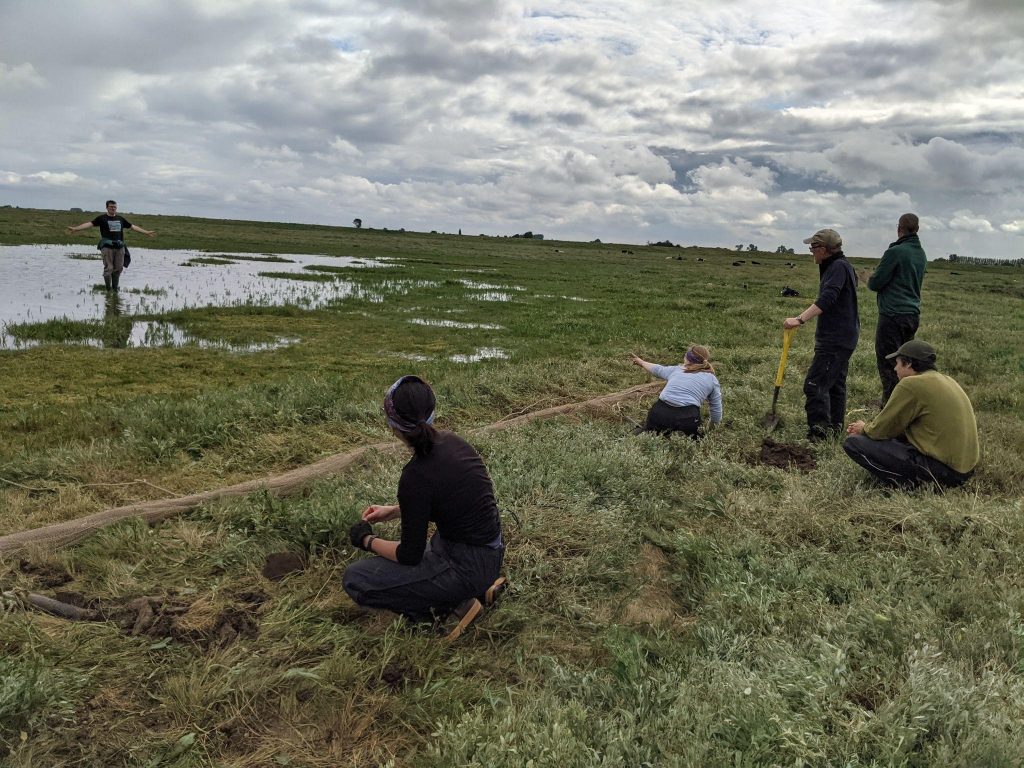
The team set on the saltmarsh at Gedney in the afternoon joined by Chantal, Guy, Ryan and Lizzie. After some final cattle wrangling everyone had a picnic supper back at the cars before most of the team settled out under a tarp to wait. There were some ‘stonking’ Grey Plover around but a harrier moved them too much and they didn’t come back. With some of the team getting a little soggy (though only in a few places!), the decision was made to pack up and head back to base. Steve joined the team at the Norfolk base and the kit was exchanged for the morning’s equipment and a briefing was had before bedtime.
Monday 23 August
Everyone was up early to leave at 5 am for Heacham South to set nets to catch Sanderling just above the dam (Nigel went back to Sandringham at the same time). Annoyingly on arrival an unexpected large flock of Oystercatcher were on the beach and disturbed by the group coming over, but two nets were soon set just behind a ridge and half the team scattered north and south to find the birds and bring them back to nets. A first net was fired when an initial lot of birds was moved down into position but the second was left in case the birds moved back to allow a second fire. The team soon got set up for ringing and processing and were half-way through when the call came that a second fire was likely so everything was put on hold and people in place. A couple of incidents with a dog getting tangled in the jiggler (and it then unhelpfully wound in!) and a cyclist on the beach didn’t deter a second fire and soon we had a nice catch to add to the first catch. A final total of 60 meant that there was some time for double winging and Nigel was able to arrive in time to ring a bird too! He’d also had some nice views of adult and juvenile Curlew at the top of Ken Hill with a head started bird (0T) included with two other juveniles.
Heacham South (fire 1)
| Species | New | Retrap | Total |
| Oystercatcher | 2 | 2 | |
| Sanderling | 32 | 2 | 34 |
| Totals | 34 | 2 | 36 |
Heacham South (fire 2)
| Species | New | Retrap | Total |
| Sanderling | 28 | 28 | |
| Turnstone | 2 | 2 | |
| Totals | 30 | 0 | 30 |
Once all birds were released the team packed up and headed back for breakfast by 11 am and the evening plans for Wainfleet were put in motion. Lizzie and Katharine headed off early to get some extra food and the team all met up at Wainfleet for a picnic dinner and a walk out onto the marsh (well done to all for carrying the kit so far!). Two nets were soon set and everyone got undercover to await the bird’s arrival. Annoyingly the birds didn’t make a pre-roost and arrived in the wrong place given where the nets were and though there was talk of ‘banana peel’ techniques the decision was made to pick up the nets. A second try would be made the next evening so all the kit (bar the electrics) was left undercover in a neat mound and Lynne came across as she’d arrived whilst we were waiting. The majority of the team drove back to the base but Ryan, Steve, Rob and Ros camped to make some morning resightings and set a net on the lagoon for the following day. Some final recce plans were made once people were back at the base before all went to bed.
Tuesday 24 August
Another set of recces were made in the morning with Katharine, Chantal, Paul and Hillary out on the inner sea wall at Ken Hill looking for Curlew, Lizzie and Nigel at Sandringham, and Lynne went to Ongar Hill (Barrie and Kirsty were picking up the shopping at 12 pm). Ken Hill proved quiet again for Curlew, with only three seen, but 12 Ruff were also present along with a nice variety of other birds including a Green Sandpiper. Nigel and Lizzie had large flocks of Knot near Snettisham and at Sandringham the muddy pools looked good for mist netting with 10 Curlew coming in (including two Wash flagged birds) plus Golden Plovers and Shelduck around.
Ongar Hill didn’t have much to report this time as there wasn’t much water visible. Everyone then came back and got packed ready for Wainfleet, including camping kit to stay over for the morning’s lagoon catch. In Lincs, the team recceing at Freiston (Rob & Ryan) had success with colour-ring reading including some Norwegian Oystercatchers, Steve was at the Lagoon which again had Oystercatchers and Grey Plovers (plus Peregrine and Marsh Harrier) and Wainfleet still looked nice for Oystercatchers from Ros’ report. The full team all met at 3:30 pm and were soon out setting the two nets in slightly different places and were under cover by 5 pm. Some kip was had by the team. At last the birds came in and, though there were similar potential catches in both nets, only one was fired with the birds quickly lifted onto dry land and prepared for ringing. There was a nice mix of ages and Sam was also able to deploy two GPS leg loop harnesses on Oystercatchers allowing the group to understand more about their movements on the west side of The Wash. When all was done, the team packed up and headed back to the car and then onto the lagoon to camp ready for the morning.
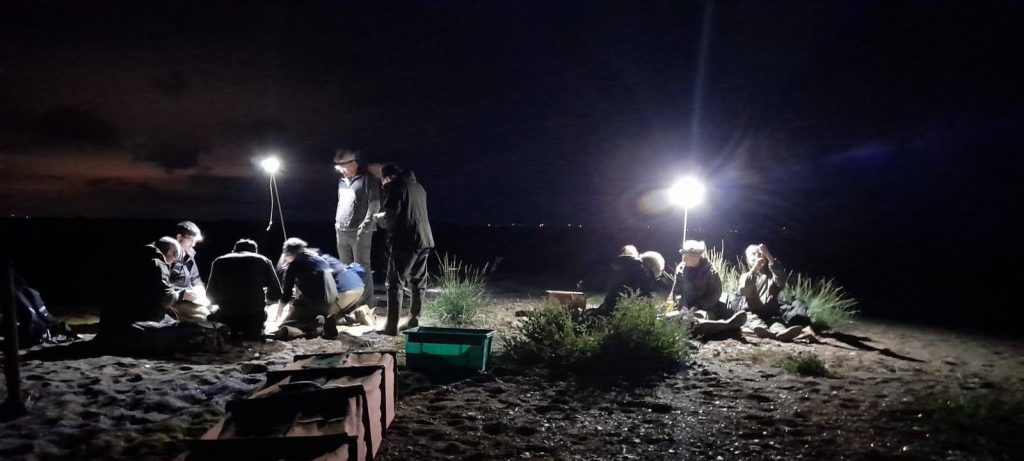
Wainfleet Island
| Species | New | Retrap | Total |
| Oystercatcher | 35 | 8 | 43 |
| Sanderling | 31 | 31 | |
| Dunlin | 2 | 2 | |
| Totals | 68 | 8 | 76 |
Everyone was up at 6:20 am ready to head round to the sea wall to wait for the tide to fill the lagoon. The Oystercatchers were in soon and slowly moving up into the catching area. Nigel and Jacquie joined us in time to see the fire. During the wait the base camp team had some amazing views of a shrew swimming out to sea as the tide came in! Meanwhile Steve and Nigel discussed how best to improve the cannon-net range with additional cannons added to the net. We caught Oystercatchers, including a highly Leucistic retrap, and a beautiful Grey Plover in summer plumage. Again, it proved a good opportunity to take double wings and double bill measurements and the catch was processed before midday. Phil arrived during the processing.
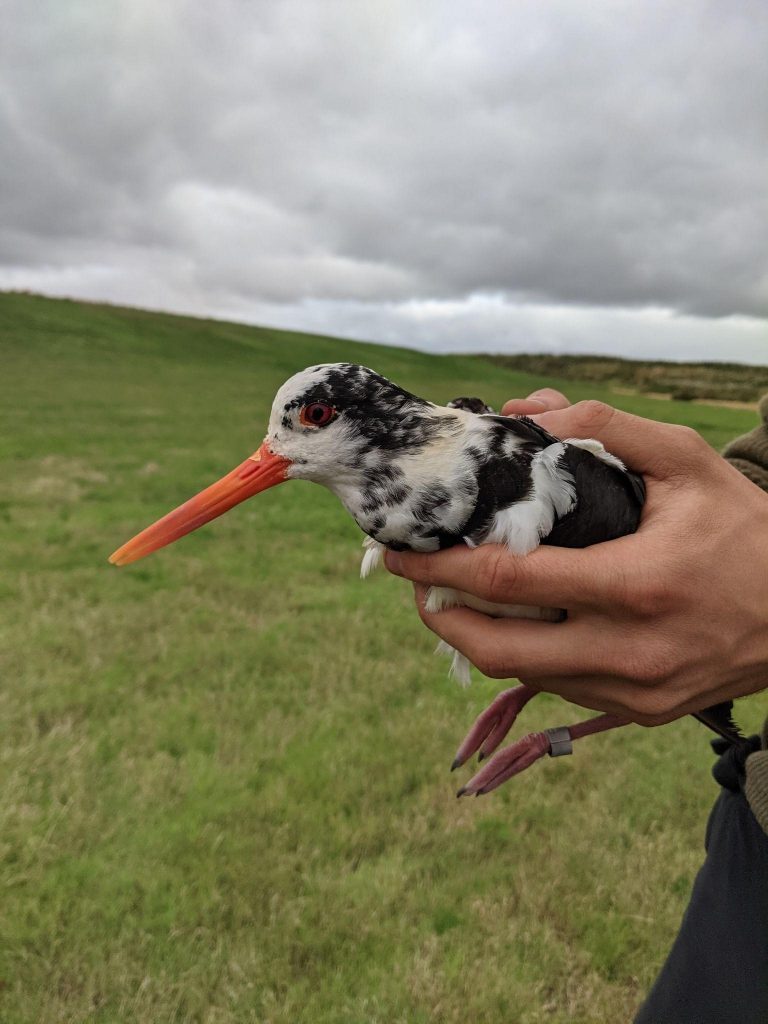
Horseshoe Lagoon
| Species | New | Retrap | Total |
| Oystercatcher | 107 | 10 | 117 |
| Grey Plover | 1 | 1 | |
| Totals | 108 | 10 | 118 |
The team then split with half heading back to Norfolk as mist-netting was planned in both locations. As the Norfolk team drove back round, the Lincs side took the opportunity to have a pub lunch as the local café was closed! Once the Norfolk team returned to base, they had their breakfast/lunch at 4 pm before heading out to set nets on the cannon-netting pool at the white barn. After setting the nets, Kirsty stayed out on the sea wall and to watch the nets and deal with the cows while the others returned for a delicious soup made by Cathy and Hilary. Guy tried out the thermal imaging camera while the team were sitting out on the saltmarsh.
The Lincs side set on the Lagoon as they couldn’t get hold of the Friskney farmer but this proved fortuitous as the winds picked up strongly and both sides caught fewer than expected with 24 in Norfolk and 17 in Lincs being the final totals. The Lincs side did see a good variety of birds with eight species ringed including three new species for Paul and one for Ros during the process!
Horseshoe Lagoon (mist-netting)
| Species | New | Retrap | Total |
| Oystercatcher | 3 | 3 | |
| Ringed Plover | 1 | 1 | |
| Knot | 4 | 4 | |
| Dunlin | 5 | 5 | |
| Bar-tailed godwit | 1 | 1 | |
| Green Sandpiper | 1 | 1 | |
| Redshank | 1 | 1 | |
| Greenshank | 1 | 1 | |
| Totals | 17 | 0 | 17 |
Terrington (mist-netting)
| Species | New | Retrap | Total |
| Dunlin | 2 | 2 | |
| Black-tailed godwit | 1 | 1 | |
| Redshank | 13 | 13 | |
| Greenshank | 1 | 1 | |
| Turnstone | 7 | 7 | |
| Totals | 24 | 0 | 24 |
Thursday 26 August
On Thursday morning the teams went out to check on birds around the area. In Lincs they were pleased to see that the Oystercatchers and Grey Plovers came back to the catching area meaning that there would be a good option to catch there again in a couple of weeks’ time. The others went to Freiston and recorded a few Redshank flags. On the other side Cathy, Rob and Guy went out to see what the new pools at Wolferton, Sandringham were like and gave very positive reviews with Curlew, Knot and Godwit around though there were some issues with the hide and rising tide, so they had to beat a hasty retreat! Lynne checked out Hunstanton where the waves were coming onto the promenade. Phil went to Ken Hill whilst Barrie, Chantal, Sam and Skye went to Snettisham Pits where they resighted several marked Oystercatchers, Black-tailed Godwits and Curlew.
A decision was made to call off any more mist-netting as the winds were going to be too high but the opportunity was taken to get some work done around the base. Everyone drove back from their respective locations to a cooked breakfast, after which a good afternoon’s work was had with jigglers sorted, netting cut up, kit cleaned and trailers loaded before a vigorous game of ‘tumble-a-grams’ with Skye. Dinner was at 7 pm, an amazing array of roast veg and meats (thank you Kirsty for this!) before a relaxed evening of discussion and chat. Guy also made guys during this process which isn’t confusing at all right? Many thanks go to Paul who brought a bottle of Talisker which was a tasty end to the evening!
Friday 27 August
The final morning started with a bang, literally, as the new 7-cannon net design was tested on a field behind the base, though Steve had to leave before this started. Given the size of the team there were comments that the set up was slower than expected but with Skye’s help (youngest person to press the button ever?) the net went out relatively smoothly. A few tweaks will be made to the design, but it looks like a good option to help catch the large flocks on places such as the Horseshoe Lagoon where birds stay slightly further out. Some new black powder was also tested in comparison to the old and proved an explosive event – the new powder sent the projectile 204 m vs 161 m for the old! A final breakfast was had before people started leaving and the house was closed down ready for the next visit in a couple of weeks’ time.
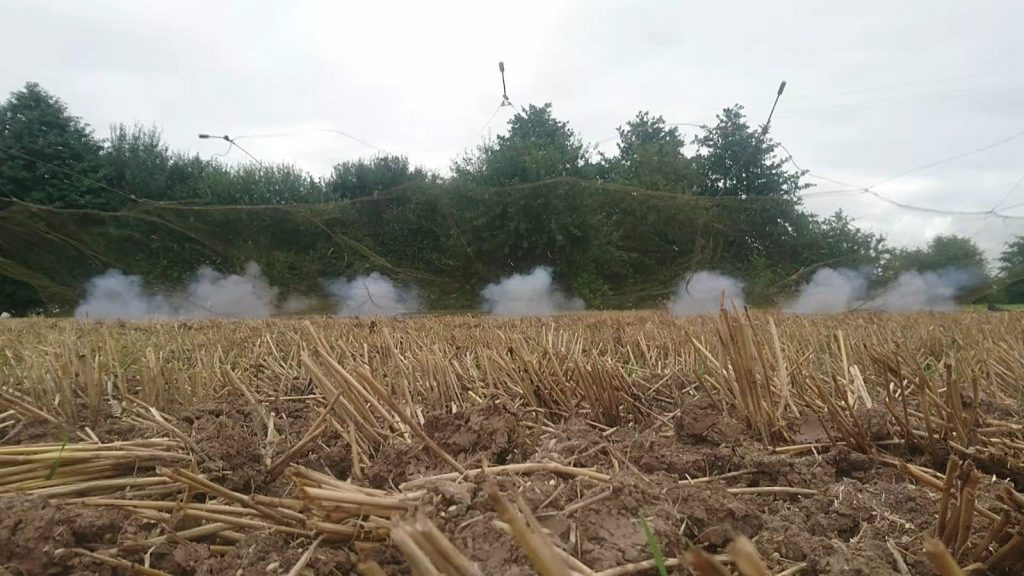
Thanks for all for a great week and hope to see you all again soon!
Trip Ringing Totals 21 – 27 August 2021
| Species | New | Retrap | Total |
| Bar-tailed godwit | 1 | 1 | |
| Black-tailed godwit | 1 | 1 | |
| Dunlin | 9 | 9 | |
| Green Sandpiper | 1 | 1 | |
| Greenshank | 2 | 2 | |
| Grey Plover | 1 | 1 | |
| Knot | 4 | 4 | |
| Oystercatcher | 147 | 18 | 165 |
| Redshank | 14 | 14 | |
| Ringed Plover | 1 | 1 | |
| Sanderling | 91 | 2 | 93 |
| Turnstone | 9 | 9 | |
| Totals | 281 | 20 | 301 |
Resighting
Resighting took place on several days on both the Lincolnshire and Norfolk sides of The Wash. The main focus on the Lincolnshire side was to resight WWRG colour-marked Redshank at Freiston Shore and Frampton Marsh. The majority of the Curlew resightings on the Norfolk side were made whilst recceing the newly discovered pools at Wolferton.
August Resighting Totals (21 to 27 August)
| Species | Sightings | Individuals | WWRG | Non-WWRG |
| Curlew | 35 | 33 | 30 | 3 |
| Bar-tailed godwit | 2 | 2 | 2 | 0 |
| Redshank | 13 | 8 | 8 | 0 |
| Turnstone | 6 | 6 | 6 | 0 |
| Black-tailed Godwit | 5 | 5 | 0 | 5 |
| Oystercatcher | 16 | 12 | 0 | 12 |
| Totals | 77 | 66 | 46 | 20 |
Interesting Sightings
Curlew resightings included three birds from the Norfolk headstarting project, one at Ken Hill and two at Wolferton Pool. There were a surprising number of Oystercatcher resightings during the trip, eight from Freiston Shore and four from Snettisham pits. Ten of these were colour-marked in Rogaland (in southern Norway), two of which had been initially caught by WWRG, one in 2009 at Snettisham and the other in 2015 at Holbeach St Matthew (with colour-marks added in Norway). Of the two other Oystercatchers, one was ringed by Jim Wilson in Nordvalle, Lofoten and the other by the Devon and Cornwall Wader Ringing Group. The Devon and Cornwall Oystercatcher, seen at Snettisham pits was also seen there during the August 2020 fieldwork.

